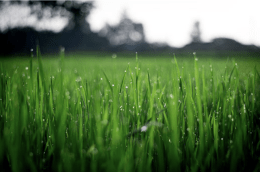By Dr. Jack Fry, Professor and Extension Specialist
- September is the optimum time to seed cool-season grasses.
- Use good quality, certified seed; avoid seed with significant levels of “weed” and “other crop.” More information HERE
- Use recommended seeding rates with good distribution – more than one direction; seeding at rates too high can cause issues with disease and environmental stress.
- Seed to soil contact is critical!

- If renovating an existing stand of turf, mow low to reduce competition with seedlings and help improve seed contact with soil.
- Aeration, slit seeding, topdressing, or raking to cover seed are methods of enhancing seed-to-soil contact contact. If thatch levels are high, seed-to-soil contact may be difficult to get without thatch reduction first.
- Aeration brings soil the surface, and is often done in concert with vertical mowing, which breaks up cores and also creates small furrows in which seed can make contact with soil.
- Slit seeders create furrows in the soil surface and drop the seed into them.
- Topdressing or raking loose soil in a tilled area covers seed and ensures contact.
- If the desire is to convert from one species to another, and a reasonable stand of turf exists, it will have to be removed before conversion happens. Removal is typically accomplished with a nonselective herbicide.
- Managing a high-traffic athletic field? Consider allowing for presence of a “seed bank” through the playing season. More information HERE
- Starter fertilizers, that contain nitrogen and phosphorus, help enhance establishment.
- Light, frequent irrigation is needed the first few weeks after planting, and may be required several times daily, depending upon weather.





